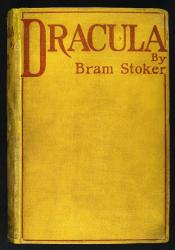"Dracula" and the History of the Vampire in Victorian Lit
In 1897, Bram Stoker published what is now one of the foremost works of literature on the subject of vampires, Dracula. The popularity of this novel and the ways in which establishes the characteristics of a vampire to the point that almost any modern work of fiction (be it literary, film, or other) taking on the subject is forced to either assume the canon established by Stoker or else explicitly address and explain any variations. However, while Dracula is commonly regarded as the prototypical vampire story, it is notable that it wasn’t published until very late in the Victorian Era, an era seemingly obsessed with the vampiric figure.
Throughout the Victorian Era, references to vampires can be found scattered all throughout British literature. For instance, Edmond Dante, the protagonist of Alexander Dumas’ The Count of Monte Cristo (1844) was regarded in-text as resembling the Eastern European image of the vampire more than half a century before Stoker publish Dracula. Aside from mere references, the romantic vampire genre had already been established at the beginning of the century with a notable number of text belonging to the genre well established long before Stoker ever began writing his masterpiece.
In 1819 John William Polidori wrote what is widely regarded as truly the first romantic vampire story in which he combines and defines many elements of vampirism into a singular image and thereby gave birth to a whole new genre of fantasy fiction: The Vampyre. This short story tells of a young man named Aubrey who befriends a mysterious stranger named Lord Ruthven. They travel together to Rome where they are separated but are reunited sometime later in Greece where Aubrey has met and fallen in love with Ianthe, an innkeeper’s daughter. Unfortunately, shortly after Ruthven’s arrival, Ianthe is murdered and found with her throat slashed and torn. While the town murmurs rumors of vampires, Lord Ruthven consoles the grieving Aubrey and together they continue their travels. Along the way, they are attacked, and Lord Ruthven is gravely injured. He insists that Aubrey vow not to speak a word of him or his death for a year and a day, which Aubrey does. Aubrey swears; Ruthven dies. Sometime later, but before the lapse of that year, a man named Earl of Marsden enters the scene and seduces Aubrey’s sister. Aubrey, recognizing the earl as Lord Ruthven, longs desperately to dissuade his sister yet is bound by an oath. However, when he learns of her engagement to the earl he resolves and writes to her telling her all. Unfortunately, Aubrey dies, and his letter is delayed. His sister is found dead, drained of blood, on her wedding night with her husband nowhere to be found. This first of this kind of story establishes the vampire not only as a blood-sucking monster with apparent immortality and seemingly mystic abilities, but also as an inherently sexual being.
This theme of the vampire as a seducer of women is expanded in 1972 by Sheridan Le Fanu. In Fanu’s novella, Carmilla, the antagonist is a vampiress- a female vampire who preys upon Laura, a young Austrian girl. Though not explicit, this narrative contains themes of homosexuality and the homoerotic in terms of lesbianism. Additionally, this story includes additional characteristics of a vampire - including it being a creature of the night, describing its bite as two small pin-like pricks, and its ability to shapeshift and breach locked doors – as well as depicting methods in which to fight and ultimately kill the creature.
Eventually Dracula is published. This story seems to provide a culminative definition of what it is to be a vampire. Stoker provides a history/origin for the beast (it being of foreign origin, pagan or otherwise separate from Christianity), identifies its particular strengths and weaknesses, how it infects versus how it simply kills, how it itself can be killed, and ultimately maneuvers each of these pieces within the scope of Christianity, defining it as a soul-less being trapped eternally in this temporal realm unable to progress toward salvation. In this context, its powers are derived of evil, and its weaknesses lie in that which is holy, and to kill it is a mercy, freeing the soul to pass on.
Although Dracula is merely a progenitor and not primogenitor of the romantic vampire genre, it is nonetheless significant that it arrives so late in the Victorian Era. Throughout this period, Eastern European immigration was a notable concern to the British populous, assimilating into society bloodlines and religious beliefs that had hitherto been commonly viewed and impure and dangerous. In an ironic attempt to create a fantastical analogy for these xenophobic Western values and the alleged dangers of combining that which was “civilized” and “correct” with that which was “foreign,” “ungodly,” Stoker adopts this now popular figure derived from Eastern European folklores to present this story.
Works Cited
Carol A. Senf. The Vampire in Nineteenth Century English Literature. Popular Press, 1988. EBSCOhost, discovery.ebsco.com/linkprocessor/plink?id=4e73f270-08f9-3766-b46c-7fdec0909089.
Polidori, John William. The Vampyre: A Tale. The Floating Press, 2009. EBSCOhost, discovery.ebsco.com/linkprocessor/plink?id=63e1b5b6-e469-3966-913d-48bdac3c813b.

